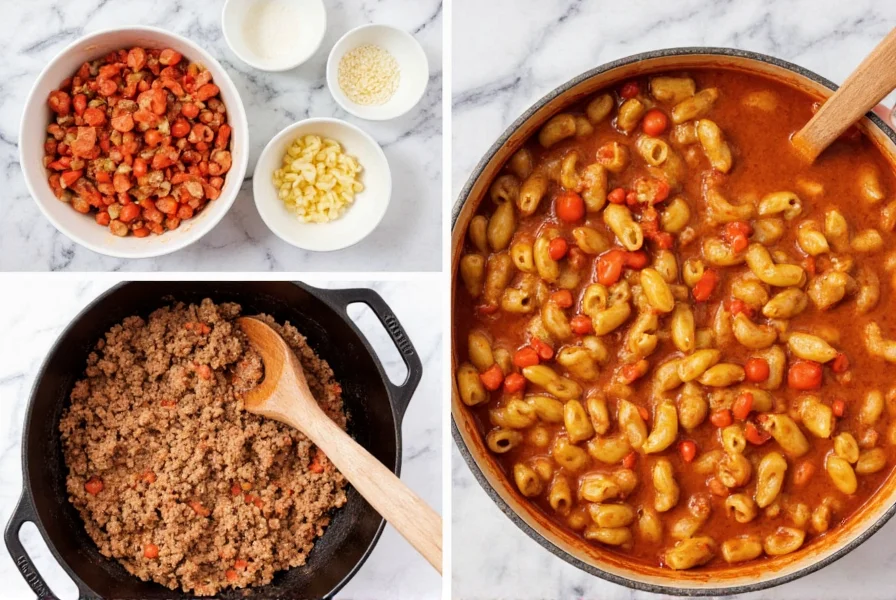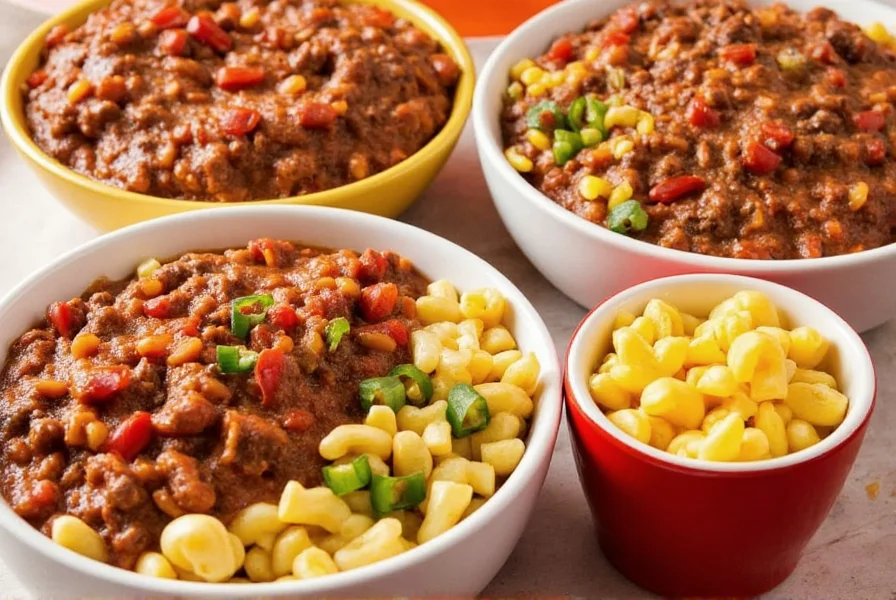Originating in the American Southwest, chili mac has evolved from its Texas chili roots to become a beloved weeknight dinner across the United States. Unlike traditional chili con carne which often omits pasta, chili mac intentionally incorporates cooked macaroni to create a more substantial, carb-forward meal that's particularly popular with families and college students seeking affordable, filling comfort food.
The Essential Components of Authentic Chili Mac
Creating exceptional chili mac requires attention to three critical elements: the meat base, the chili seasoning profile, and the pasta integration. While recipes vary regionally, the best chili mac recipes maintain certain fundamentals that distinguish them from ordinary chili.
Traditional Ingredients Breakdown
| Component | Essential Ingredients | Optional Enhancements |
|---|---|---|
| Meat Base | Ground beef (80/20 fat ratio), onions, garlic | Bacon for smokiness, beef broth for depth |
| Chili Sauce | Crushed tomatoes, tomato paste, kidney beans | Dark beer, coffee, chocolate for complexity |
| Seasoning | Chili powder, cumin, paprika, oregano | Cayenne, chipotle powder, cinnamon |
| Pasta | Elbow macaroni (cooked al dente) | Shells, penne, or gluten-free alternatives |
Step-by-Step Perfect Chili Mac Recipe
Follow this method for restaurant-quality chili mac that avoids common pitfalls like mushy pasta or watery sauce:
- Brown 1½ pounds of ground beef with 1 diced onion and 3 minced garlic cloves in a large pot over medium-high heat
- Add 1 (28-ounce) can crushed tomatoes, 2 tablespoons tomato paste, 1 (15-ounce) can kidney beans (drained), and 1 cup beef broth
- Stir in 3 tablespoons chili powder, 1½ teaspoons cumin, 1 teaspoon smoked paprika, and ½ teaspoon oregano
- Simmer uncovered for 30 minutes to develop flavors while pasta cooks separately
- Cook 8 ounces elbow macaroni to al dente (1 minute less than package directions)
- Drain pasta and rinse briefly with cold water to stop cooking
- Gently fold pasta into the chili mixture and simmer for 5-7 minutes to allow flavors to meld

Mastering the Perfect Texture
The most common mistake in making chili mac is ending up with soggy pasta. The secret lies in cooking the pasta separately and adding it near the end of the cooking process. When pasta cooks directly in the sauce, it releases starch that breaks down the sauce's texture and becomes unpleasantly soft. For the best results, cook your macaroni to just shy of al dente, then finish cooking it in the chili for only 5-7 minutes.
Popular Variations for Different Preferences
While traditional chili mac features beef and beans, numerous adaptations accommodate different dietary needs and flavor preferences:
- Texas-Style Chili Mac: Omit beans and use only meat, tomatoes, and spices for a more authentic regional version
- Vegetarian Chili Mac: Substitute textured vegetable protein or extra beans for meat, using vegetable broth
- Slow Cooker Method: Brown meat first, then transfer to slow cooker with all ingredients except pasta; add cooked pasta during last 30 minutes
- Spicy Chipotle Version: Add 1-2 minced chipotle peppers in adobo sauce for smoky heat

Serving Suggestions and Pairings
Chili mac shines when served with complementary sides that balance its hearty nature. Top with shredded cheddar cheese, sour cream, and sliced green onions for classic presentation. For complete meal pairing, consider:
- Cornbread or garlic bread for dipping
- Fresh green salad with tangy vinaigrette
- Coleslaw to cut through the richness
- Simple steamed vegetables for lighter balance
Storage and Reheating Best Practices
Chili mac makes excellent leftovers as flavors continue to develop. Store in airtight containers in the refrigerator for up to 4 days or freeze for up to 3 months. When reheating, add a splash of water or broth to restore moisture, as the pasta will continue absorbing liquid during storage. Microwave with a damp paper towel over the container, or gently reheat on the stovetop over low heat while stirring occasionally.
Avoiding Common Chili Mac Mistakes
Even experienced cooks can stumble with this seemingly simple dish. Watch for these pitfalls:
- Overcooking the pasta: Always cook pasta separately and add near the end
- Skipping the bloom step: Cook spices in oil for 1 minute before adding liquids to enhance flavor
- Using low-quality chili powder: Fresh, high-quality chili powder makes a dramatic difference
- Not adjusting acidity: A splash of apple cider vinegar or lime juice at the end brightens flavors
- Underseasoning: Chili mac needs generous seasoning; taste and adjust before serving
Frequently Asked Questions
What's the difference between chili mac and regular chili?
Chili mac specifically includes cooked macaroni pasta integrated into the chili, while traditional chili con carne typically contains no pasta. Regular chili often has a thinner consistency designed for serving over rice or with cornbread, whereas chili mac has a thicker sauce that properly coats the pasta without becoming watery.
Can I make chili mac without beans?
Yes, you can absolutely make chili mac without beans. Traditional Texas-style chili doesn't include beans, focusing instead on meat, tomatoes, and spices. If omitting beans, consider adding an extra ½ cup of beef broth and perhaps some diced bell peppers for additional texture and flavor complexity.
How do I prevent my chili mac from becoming too watery?
To prevent watery chili mac, simmer the chili base uncovered for at least 30 minutes before adding pasta to reduce and concentrate flavors. Use tomato paste (not just canned tomatoes) for thickness, and avoid overloading with liquid ingredients. If your chili mac becomes too thin, create a slurry with 1 tablespoon cornstarch mixed with 2 tablespoons cold water, then stir it into the simmering mixture.
What's the best pasta shape for chili mac?
Elbow macaroni remains the classic choice as its curved shape holds sauce well. However, other small pasta shapes work beautifully too: shells capture sauce in their cavities, mini penne offers more surface area, and ditalini provides a smaller bite. Avoid very thin pastas like angel hair that might disintegrate, or large shapes that won't distribute evenly throughout the dish.
Can I prepare chili mac ahead of time?
Yes, chili mac actually improves when made ahead as flavors meld. Prepare the chili base without pasta, cool completely, then refrigerate for up to 2 days. When ready to serve, reheat the chili base, cook the pasta separately to al dente, then combine and simmer for 5-7 minutes. This method prevents the pasta from becoming mushy during storage.










 浙公网安备
33010002000092号
浙公网安备
33010002000092号 浙B2-20120091-4
浙B2-20120091-4